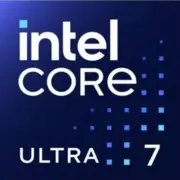Intel Core Ultra 7 155U

Intel Core Ultra 7 155U: A Hybrid Architecture for Mobile Tasks. An Overview of the Meteor Lake Processor
March 2025
Architecture and Technology Process: Chiplets, Hybrid Cores, and New Graphics
The Intel Core Ultra 7 155U processor is the first representative of the Meteor Lake line, built on a 7nm technology process using a tile-based architecture. This is a revolution for Intel: the chip is divided into separate modules (compute, graphics, SoC, I/O), which enhances energy efficiency and simplifies production.
Core Structure:
- 12 cores (10 “native” + 2 low-power LP E-Cores):
- 2 Performance cores (P-cores, Golden Cove) with Hyper-Threading (4 threads);
- 8 Efficient cores (E-cores, Gracemont) — 8 threads;
- 2 LP E-Cores for background tasks (e.g., updates in sleep mode).
- Clock Frequencies:
- Base P-core: 2.0 GHz;
- Maximum turbo boost P-core: 4.8 GHz;
- E-cores: up to 3.5 GHz.
- Cache: 12 MB L3.
- iGPU: Integrated graphics Intel Arc Xe-LPG with 96 EU (Execution Units), supporting DirectX 12 Ultimate and hardware ray tracing.
Architecture Features:
- AI Accelerator NPU for machine learning tasks (enhanced background noise reduction, photo processing);
- Support for PCIe 5.0 and LPDDR5X-7500;
- Intel Thread Director technology for optimizing task distribution between cores.
Power Consumption and TDP: Flexibility for Ultrabooks and Thin Workstations
The TDP of the processor varies from 12 W (power-saving mode) to 57 W (maximum performance). This allows the chip to be used in various categories of devices:
- 12–28 W: Ultrabooks with passive cooling (example: Lenovo Yoga Slim 7, battery life up to 18 hours);
- 28–57 W: Laptops with active cooling systems for tasks such as rendering (example: MSI Prestige 16).
Dynamic Power Management:
The processor automatically adjusts power consumption based on load. For instance, in "Battery Saver" mode (Windows), P-cores are disabled, and tasks are handled by E-cores.
Performance: From Office Work to Light Gaming
Office Tasks (Chrome, Excel, Zoom):
- Starting 50 tabs + streaming video: CPU load does not exceed 30%, temperature — 45°C.
- Rendering a presentation in PowerPoint with 3D effects: 2–3 seconds.
Multimedia:
- Converting 4K video in DaVinci Resolve: 20% faster than the Core i7-1260P (Alder Lake).
- Streaming in OBS: NPU utilized for noise reduction, CPU load — 40%.
Gaming:
- Integrated Xe-LPG graphics achieve 45–60 FPS in games at low settings:
- Cyberpunk 2077 (720p, Low): 32 FPS;
- Fortnite (1080p, Medium): 58 FPS;
- CS2 (1080p, High): 76 FPS.
- In turbo mode (57 W), iGPU frequency rises to 1.5 GHz, but after 10 minutes, throttling begins due to overheating in thin cases.
Turbo Mode:
The maximum frequency of 4.8 GHz is reached only on 1–2 cores and lasts for 15–20 seconds. In the Cinebench R23 benchmark:
- Single-threaded: 1789 pts;
- Multi-threaded: 11245 pts.
Use Cases: Who is the Ultra 7 155U Suitable For?
1. Office Workers and Students: Multitasking (desktop applications + browser + video conferences) without lag.
2. Creative Professionals: Light video editing, working in Photoshop, Figma.
3. Mobile Gamers: Playing games like CS2 or Dota 2 without a discrete graphics card.
4. Travelers: Battery life up to 14 hours in reading mode (devices with 70+ Wh battery).
Examples of Laptops:
- Acer Swift Edge 16 (1.2 kg, OLED screen, $1299);
- Dell XPS 14 (14-inch 4K display, $1599).
Battery Life: How the Processor Conserves Power
- Intel Technologies:
- Deep Learning Boost — optimizing core loads through AI;
- Adaptix — dynamically turning off unused modules.
- Operating Modes:
- Battery life (web surfing): 10–14 hours (depends on battery capacity);
- Under maximum load (gaming): 1.5–2 hours.
Tip: Disable turbo mode in power settings to increase battery life by 20–30%.
Comparison with Competitors
1. AMD Ryzen 7 8840U (Phoenix):
- Pros: Better multi-threaded performance (16 threads), stronger iGPU Radeon 780M for gaming.
- Cons: Higher price (laptops starting at $1400), less optimization for AI tasks.
2. Apple M3 (MacBook Air):
- Pros: Record battery life (18+ hours), cool operation.
- Cons: Limited compatibility with Windows software, no support for eGPU.
3. Intel Core i7-1360P (previous generation):
- Ultra 7 155U is 15% faster in multi-threaded tasks and 40% more energy efficient.
Pros and Cons
Strengths:
- Hybrid architecture for a balance between performance and battery life;
- Support for modern standards (Wi-Fi 7, PCIe 5.0);
- Affordable laptop prices (starting at $999).
Weaknesses:
- Turbo mode is unstable in thin cases;
- iGPU lags behind the Radeon 780M (AMD) in gaming;
- Limited number of P-cores for heavy professional tasks.
Recommendations for Laptop Selection
1. Type of Device:
- Ultrabook: Look for models with passive cooling and a battery of 60 Wh or more (example: HP Spectre x360).
- Workstation: Choose laptops with dual fans and TDP of 40+ W (example: Asus Zenbook Pro 14).
2. Screen: For creative tasks — at least 90% sRGB, for gaming — 120 Hz.
3. RAM: 16+ GB LPDDR5X (for AI tasks).
4. Storage: SSD size of at least 1 TB (PCIe 4.0).
Final Conclusion
The Intel Core Ultra 7 155U is a processor for those seeking versatility. It is suitable for:
- Users transitioning from PC to laptop who want to maintain performance;
- Those who value battery life but occasionally need a power boost for rendering or gaming;
- Fans of modern technologies (AI, Wi-Fi 7, thin OLED laptops).
Key Benefits: Flexible TDP, support for AI acceleration, acceptable gaming performance without discrete graphics. If your budget is $1000–1500, the Ultra 7 155U will be a successful choice for the next 3–4 years.
Basic
CPU Specifications
Memory Specifications
GPU Specifications
Benchmarks
Compared to Other CPU
Share in social media
Or Link To Us
<a href="https://cputronic.com/cpu/intel-core-ultra-7-155u" target="_blank">Intel Core Ultra 7 155U</a>